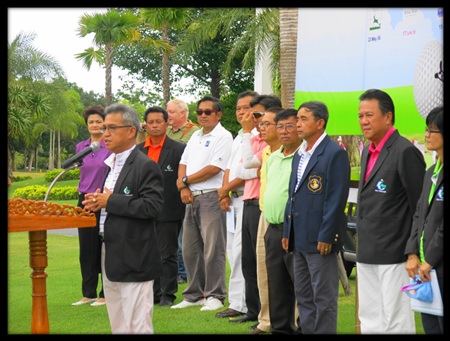Most Farang know him as Mike. His real name is Kullatorn Mesommonta and he has been around Pattaya golf, in one capacity or another, for years. Mike is the wearer of many hats, including Manager of Burapha Golf. But it is as President of the East Coast Golf Course Management Association (East Coast Golf) where he wields most influence.
East Coast Golf is a collective representing some 18 golf courses in and around Pattaya. Among the courses not represented by Mike’s organisation are Crystal Bay, Mountain Shadow, Pattaya Country Club and Rayong Country Club. In his capacity as Association President, Khun Mike is the most influential individual in Pattaya golf, by far.
 Kullatorn Mesommonta (Mike) welcomes competitors to sectional qualifying for this year’s Caddie Championship at Siam Plantation.
Kullatorn Mesommonta (Mike) welcomes competitors to sectional qualifying for this year’s Caddie Championship at Siam Plantation.
“My job is to create demand for golf tourism, and it never stops,” he told me in a recent interview. “In 2012 we knew we were on the right track when Pattaya was named the number one ASEAN golf destination. Pattaya won this prestigious award because it represented the best value-for-money. Our job is to keep it there.”
A few weeks back, the Golfnutter column wrote of the fear that Farang influence over golf course management was waning, that ever-increasing costs threaten continued Farang golfing custom, and that carts are inexorably moving towards becoming mandatory, no matter where one plays golf. The article also cited the President of the East Coast Golf Course Management Association as being a prime mover of compulsory carts. Mike, given a right of reply, denied not only his reported stance on compulsory carts, but on the underlying theme of the entire article.
“I have never had the intention that all courses should impose carts on all golfers. Some courses are well set-up for walking, others are not. If a course is mountainous, then walkers will slow up play. Imposing carts in these conditions does a lot to stop complaints about slow play. Also, many Farang golfers are retirees. The cart offers relief from our hot sun. Lastly, some courses have significant distance from green to tee, which in itself, can justify compulsory carts. But as to compulsory carts for all courses – no I don’t support that.”
Below is some more of the revealing interview with Mike:
Golfnutter: A large part of the cost of a day’s golf will be the cost of the caddie – about 750B including tip – why are they compulsory?
Mike: It’s down to tradition. The use of caddies was started about 90 years ago by King Rama VI, and golf in Thailand has followed his example ever since. Today, the caddie is very much part of the “Thailand Golf Experience”. In no other country do you find the caddie interlinked with the image of golf as you do here. They are an important part of our unique brand, and will remain so.
Golfnutter: With increasing work opportunities elsewhere, caddies are becoming harder to find, and more expensive to hire. If this continues, where will it lead? What will be the outcome?
Mike: About a year back, the government introduced a minimum wage of 300B per day. We started losing caddies to factories, so we agreed to add a 50B premium in the hope of retaining our caddies. Those that go to factories work 12 hours per day, six days per week, often in menial jobs. We believe we offer a better and more interesting work environment, and show more care to our employees. Programmes such as the Singha Amazing Thailand Caddie Championship, an annual event that attracts entries from caddies at other East Asian countries, is proving a huge success. Caddies from all over East Asia attend one of seven qualifying events for a final series planned in September. Last year proved a huge success. It is one way of showing we care about our caddies. Factories don’t do that.
Golfnutter: So the cost of caddies will continue to increase?
Mike: Not necessarily. I can see a time when one caddie may look after say two golfers. It already happens in Japan and South Korea, where one caddie takes care of four players. Perhaps in five year’s time, as a way of keeping costs down, who knows?
Golfnutter: Those are the magic words – to keep costs down. To the Farang resident golfer, the chap who plays twice or three times per week, he feels he is being priced out. He feels the golf courses don’t care about anything Farang except how to get more Baht from their pocket?
Mike: “That is so wrong. Last year Pattaya golf courses hosted about 1.2 million rounds of golf. Fifty percent of those were Farang. Whoever said the Farang golfer was no longer important doesn’t know their facts. But we need to define Farang. There are those who are golf tourists, and those who live here, permanently. When we talk cost awareness, we are not talking about golf tourists. Providing we remain competitive with other golfing destinations, we will continue to attract the golf tourist. It is the resident golfer that has my sympathy.
Golfnutter: As he has mine. But what can be done to ease the costs of golfers living here and playing multiple rounds per week?
Mike: I have always been supportive of the resident Farang golfer. That is why I introduced the Gold Card offering up to 50% green-fee discount.
Golfnutter: Excuse me. You introduced the 50% green-fee discount programme?
Mike: Yes. Working through the PSC, I first wanted them to move the white card (normal membership) discount from 30% back down to 10%. We were then able to convince our member courses to accept gold card holders – those who can prove they are permanent residents – at a 50% discount. As I say, we recognise the need to treat our residents different to that of tourists. As far as I’m concerned a Farang who is a permanent resident is no longer a Farang – he is Thai.
Golfnutter: There are many Farang who will find your attitude refreshingly welcoming and supportive, not least those gold card holders of the PSC. But what about other permanent residents, who play multiple rounds per week, but choose to play from golf organisations other than the PSC – the IPGC for example?
Mike: The offer is to Farang golfers who are permanent residents, providing they play with a golf organisation we recognise as a serious golf entity. If such organisations show they can set the programme up with appropriate diligence, then fine, they could have their own gold card. We have to feel confident the system is not being abused.
Golfnutter: I take it proof of permanent residency refers to a 12-month renewable visa or a Thai driver’s license, along with a minimum five-year golf society membership card?
Mike: Yes. The card would need to be signed by a recognised officer of that organisation, like the chairman or secretary for example. Their signature confirms that proof of permanent residency has been provided.
Golfnutter: I and many other Farang have thought the relationship between Pattaya’s golf courses and we golfers should be one of a partnership. The courses need us, and we need them. I thought that was beyond the realms of reality, until talking with you. You are genuinely concerned about Farang golfers, aren’t you?
Mike: As I said, my job is to create demand for golf tourism. But equally important is to work towards customer satisfaction from our regular customers, especially the resident Farang. You are as important to us today as you have always been. We need you and you need our courses. I am very happy to work with you on a partnership basis.
***
It seems that I, for one, have unfairly maligned Mike and his fellow East Coast Golf managers. I found his attitude towards the plight of the resident Farang golfer to be reassuring and empathetic. Perhaps we can have that partnership.
Happy golfing,
Golfnutter.
 Mike (center) poses with caddies at the Singha Amazing Thailand Caddie Championship in Pattaya.
Mike (center) poses with caddies at the Singha Amazing Thailand Caddie Championship in Pattaya.




